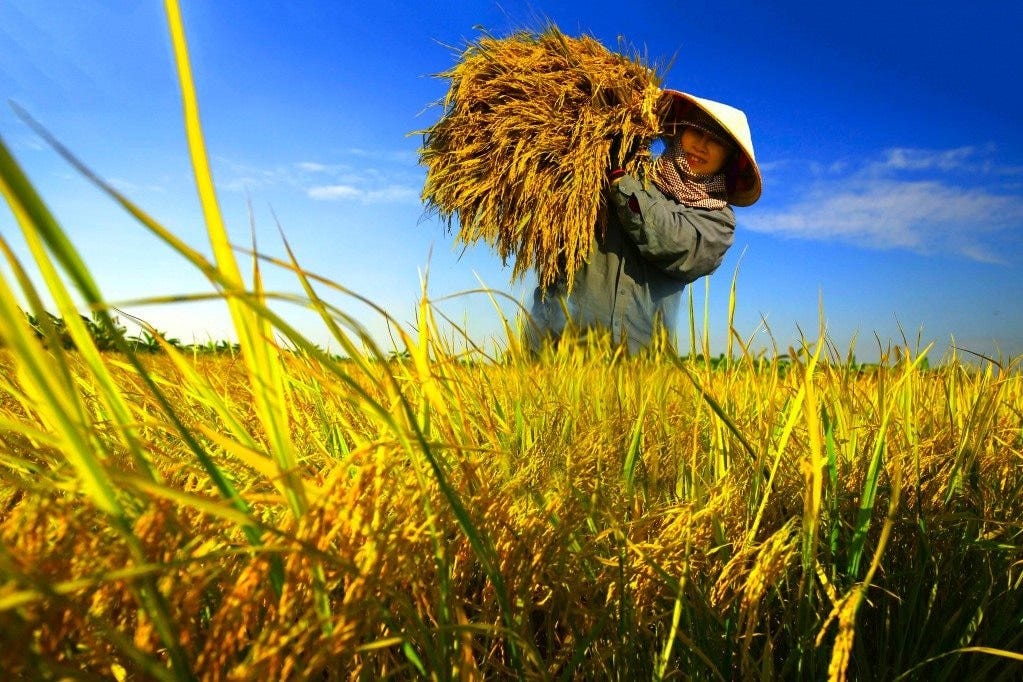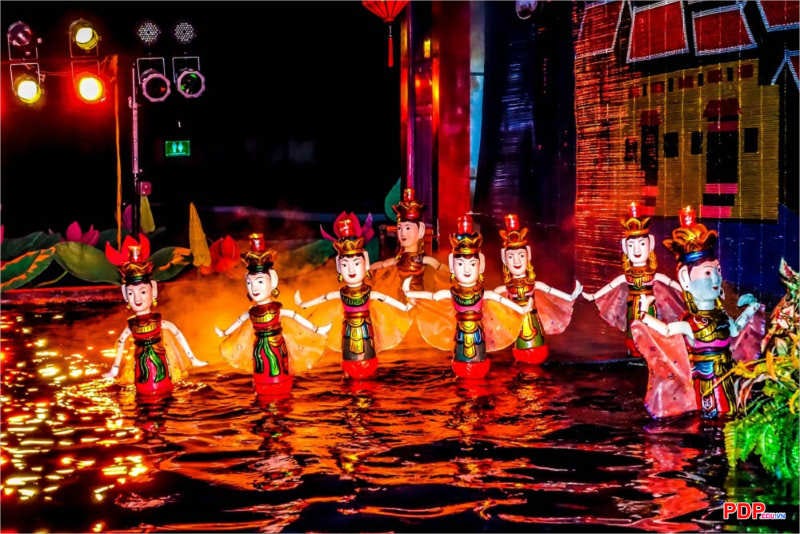When speaking of the "beauty" of the Vietnamese people, many immediately think of magnificent natural landscapes or exquisite works of art. However, there exists another kind of beauty - simple yet profound - that has silently permeated every corner of life, shaping the character and lifestyle of millions of Vietnamese people across generations. This is the "beauty" of agricultural culture.
Rustic Beauty from the Fields
The "beauty" in Vietnamese agricultural culture is not ostentatious or brilliant like gold. Instead, it carries the colors of earth and water - the brown of muddy fields, the green of young rice shoots, the golden gleam of ripened grain. This is beauty born from the harmony between humans and nature, from the calloused hands of farmers and the sweat they pour onto every plot of land.
As Professor Vu Tai Luc's research has pointed out, Vietnamese agricultural culture is "a culture of genuine combination between humans and the earth, a culture of cultivating the land alongside cultivating the spirit." Farmers do not merely regard the land as a production tool, but see it as a friend, a teacher who instructs them about patience and the rhythm of nature.
The Aesthetic of "Simplicity - Harmony - Utility"
1. In Clothing and Daily Items
Consider the conical hat (nón lá) - a familiar symbol of Vietnamese people. At first glance, it appears to be just a simple hat made from palm leaves, but in essence, it represents the crystallization of agricultural aesthetic philosophy. The conical hat serves practical purposes by providing shade and rain protection (utility), has a gently curved shape that harmonizes with nature, and embodies unpretentious simple beauty (rusticity).
Farmers' clothing also clearly reflects this aesthetic quality. The brown and black colors of their garments serve not only to hide stains from work, but also express humility - a reluctance to stand out or draw attention. This is how farmers embody the concept that "beauty is modesty, beauty is harmony."
2. In Architecture and Living Spaces
Traditional Vietnamese residential architecture provides the clearest evidence of agricultural culture's aesthetic qualities. The three-compartment house without interior walls, with its interconnected courtyard-garden-pond-livestock areas creates an open, airy living space. The gently curved roof serves not only to drain rainwater but also creates soft beauty that harmonizes with the curves of surrounding hills and mountains.
As researcher Louis Bezacier observed: "The Vietnamese can repeat the same curved-roof house style endlessly, yet we never tire of admiring it." This beauty does not result from elaborate complexity, but precisely from simplicity and naturalness - the core values of agricultural aesthetics.
Profound Impact on Lifestyle
1. Living in Rhythm with Nature
Agricultural "beauty" has created a special Vietnamese lifestyle: living in accordance with natural rhythms. Farmers wake with the rooster's crow, rest when darkness falls, and work according to seasonal cycles. This reflects not merely production needs but also a philosophy of living in harmony with nature.
As Vietnamese proverbs often say: "Heaven's grace of rain and sun must come at the right time; where it's shallow, plow lightly, where it's deep, plow deeply." This represents not only farming experience but also life philosophy: knowing how to adapt flexibly to circumstances without forcing nature.
2. Gentle Character and Community Spirit
The agricultural production environment, requiring cooperation and mutual support, has created distinctive Vietnamese characteristics: gentleness, valuing relationships and loyalty, and prioritizing community. In traditional Vietnamese villages, plowing, building dikes and embankments, and harvesting all required the entire community's participation. This formed values like "healthy leaves shelter torn leaves" and "one tree cannot make a mountain, but three trees together can form a high peak."
This differs markedly from nomadic or commercial cultures where individual competition is emphasized. In agricultural culture, "beauty" is not about outshining others, but about harmony and contributing to the community's collective prosperity.
In Arts and Entertainment
1. Water Puppetry - Art from Rice Fields
Water puppetry exemplifies how agricultural "beauty" manifests in folk art. The stage is the water surface itself - like flooded rice fields, with puppets depicting rural life: plowing buffalo, swimming ducks, rice planters. This is not "high art" for aristocrats, but art "of the people, by the people, for the people" - expressing accessible, familiar beauty.
2. Folk Songs and Proverbs - Treasury of Folk Aesthetics
Vietnamese folk language contains countless aesthetic images drawn from agriculture. Professor Do Thi Kim Lien in her research pointed out that among 2,400 proverbs, up to 446 contain words related to rice plants and rice products. Images like "ripened rice and ngâu flowers," "rice to eat and clothes to wear," and "granaries full of rice and paddy" are not merely everyday realities but have become aesthetic symbols expressing dreams of abundant, happy life.
Impact on Human Character
1. Patience and Perseverance
Farming teaches Vietnamese people the virtue of patience. From sowing seeds to harvest takes 3-4 months, and throughout this time, farmers must provide meticulous care while waiting for the right moment. This has created the patient, unhurried character of Vietnamese people. As Professor Vu Tai Luc wrote: "The farming spirit of the Vietnamese nation means understanding deep concerns and not fearing hardship and suffering."
2. Democracy and Equality
In agricultural communities, regardless of wealth or poverty, when working in the fields everyone must struggle together with mud and earth, enduring sun and rain together. This creates democratic, egalitarian social relationships. Even in ancient Vietnamese villages, the "village crier" position, though lowest in rank, would still have his own mat during festivals - showing respect for equality based on community contribution rather than social status.
3. Holistic Thinking
Farming depends on many factors: weather, soil, water, plant varieties, techniques... Therefore, farmers develop holistic thinking that focuses on relationships between elements. They don't look at isolated aspects but always consider the whole. This creates the dialectical, flexible thinking of Vietnamese people - always seeking balance and harmony rather than fierce confrontation.
Changes in Modern Times
Today, as Vietnamese society undergoes rapid industrialization and modernization, many worry that these traditional aesthetic values will disappear. However, reality shows they persist steadily, only changing their forms of expression.
1. Urban Inheritance
Even in large cities, we can still see traces of agricultural "beauty." Many families maintain habits of growing vegetables in their yards, decorating homes with ornamental plants, and preferring green, cool spaces over rigid high-rise buildings. Community spirit still manifests through new forms like neighborhood groups and resident clubs.
2. Challenges and Opportunities
However, we cannot deny that modernization brings challenges. Consumer lifestyles and individual competition strongly impact traditional value systems. Some negative aspects of agricultural thinking like conservatism, parochialism, and "leveling down" are also being reflected upon and adjusted.
Contemporary Significance
The "beauty" in Vietnamese agricultural culture is not something "outdated" to be discarded, but a valuable spiritual resource that needs preservation and development. In the context of globalization, when many countries are rediscovering their cultural identity, values like harmony with nature, community spirit, and sustainable living become extremely meaningful.
Moreover, in this era of climate change and environmental crisis, the agricultural culture's philosophy of "living in accordance with nature" becomes a valuable lesson for all humanity. As international researchers have noted in Nature journal, aesthetic values connected with nature from Asian agricultural cultures are receiving worldwide research attention.
Conclusion
The "beauty" in Vietnamese agricultural culture is not merely an abstract concept but a living value system that profoundly impacts every aspect of life. From simple dress and architecture harmonious with nature, to gentle character that values relationships and community lifestyle - all bear the imprint of agricultural aesthetic philosophy.
Understanding this, we see that Vietnamese cultural identity is not artificially created, but forged through thousands of years of living closely with the land and rice fields. And perhaps, in the nation's modernization journey, we still need to preserve these beautiful values - not as museum pieces for admiration, but as a source of spiritual strength to continue moving forward.






